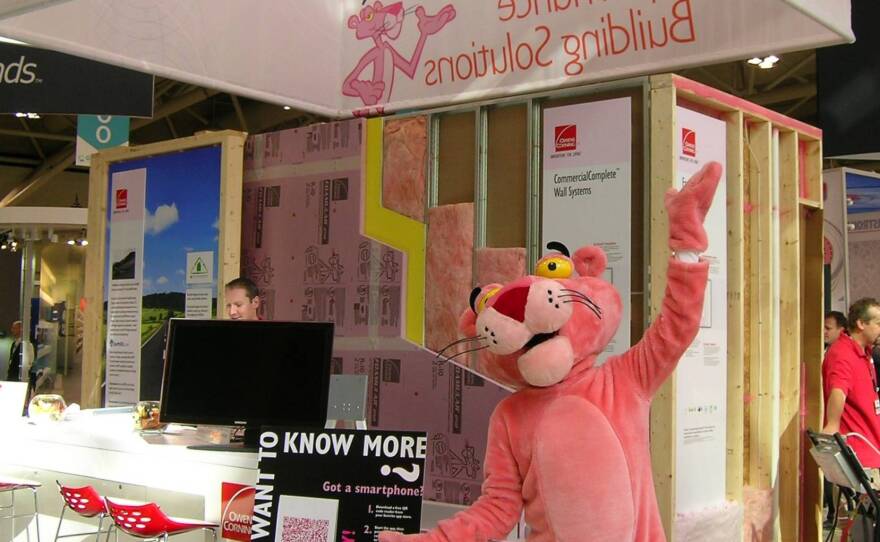The U.S. Green Building Council’s annual conference was held in Toronto this week. “Greenbuild2011” was four days of seminars, classes, and discussions about how to construct buildings and homes, using more environmentally friendly methods.
The Greenbuild conference is big. This was a down year and still about 25 thousand people came to hear about the latest ideas and technology to make buildings that waste less energy, waste less water, and are better for the environment overall.
There are 900 exhibits at this conference and I wondered, how do you make yourself stand out? I mean, you’ve got your signs and you’ve got your display and you’ve got your pitch for your idea or product all ready. But, you’re competing with 900 other ideas and products.
So, I went out on the floor to see what caught my eye. And immediately, I found sometimes it’s all in a name. The first person I talked to was Alex Reed.
“Well, the original name of the company was HVLS Fan Company. It’s an acronym for High Volume, Low Speed, which is a technology. Very boring, but very descriptive. So, everybody just said, ‘You all are the guys that make those big ass fans, right?’ So, I mean, after a couple of years of that we relented, you know, we said let’s just adopt it as our name. And then, we adopted the ass mascot as well, Fanny. And the rest is history.
LG: Your mascot’s name is Fanny?
“Yes, sir.” (laugh)
Fanny is a donkey and the company also sends some of its profits the the Longhopes Donkey Shelter in Colorado.
They are big fans.
A few aisles over I saw a display of vases of lemons and limes sitting next to a toilet.
I asked Eddie Wilcut with Coroma-USA what’s up with that demonstration?
“Flushing efficiency of our products. Normally standard U.S. toilets, siphonic, has a two inch, two-and-a-half inch trap way. The Coroma toilets are a European wash down design with a four inch trap way. So, if you’ve ever had to unclog a toilet, you know how frustrating that can be. So, if we can flush lemon, limes, potatoes, tennis balls, we can make the point you can get water efficiency and still get a good flush.”
Yeah, yeah. Siphonic. Trap ways. Efficiency. Show me the lemons and limes.
(((FLUSH sound with two lemons and a lime dropping, each with a thud)))
Hope he’s not using those for anything else later.
Most of these exhibits are kind of your standard sign-and-product stands. But, suddenly I turned a corner and saw something like a willow forest or maybe Spanish moss hanging from overhead. There were natural wood stumps. Dramatic lighting. And all these beautiful strands of unfinished carpet fibers. Did someone find a way to use sustainable wood fibers to make carpet? Wow…
“It’s made out of nylon 6-6.”
(((SCREECHING/CRASHING SOUND)))
Wait. What?
AUTOMATON VOICE DEFINITION: “Nylon. Synthetic. Made from petroleum products.”
This is not the sustainable, natural fiber I was thinking.
But, Diane O’Sullivan with Invista, makers of Antron carpet says it is sustainable.
“Sustainability begins with products that last. So, I want to sell you a fiber that will go into a commercial carpet that you’ll buy and put into a hospital or a school or a corporate office that will last as long as you need it to last, no have premature failure. “
LG: Can you recycle nylon?
“Yes, you can. There’s a lot of demand for nylon 6-6 on the recycled world especially for engineering car parts as well as going into our fiber, going back into our Antron Lumina with True Blend fiber technology.”
Alrighty, then.
You’ll hear strong arguments for a lot of products you wouldn’t immediately think of as environmentally friendly. Yeah, some of it’s just green washing, putting the best environmental spin on an old product, and some of it is not-yet-practical innovation that could show real promise for building efficiencies in the future. But this green building movement is becoming more widely accepted and businesses can see the direction is not changing. Some builders are reluctant to change sometimes… and won’t until there’s some government regulation that forces the change. But, others are embracing this green build movement because to them… it just makes sense.









